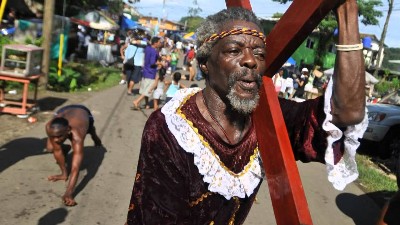The Black Christ of Portobelo

“Cristo Negro” (Black Christ), referred to by locals as “El Naza” (The Nazarene), is a life size statue of Jesus Christ carved from wood. Iglesia de San Felipe, a Roman Catholic Church located in Portobelo
Panama, is the only home the statue has known. The statue, dating back to 1658, was found on the shores of the Portobelo harbor.
For this reason, many believe that it arrived by ship. One account says the statue was aboard a ship destine for Peru. The ship was set off route by a storm, thus landing in Portobelo. After several failed attempts to leave the port in bad weather, the crew determined that they would need to leave some of the heavier cargo behind. The Black Christ was one of the items they left behind. Another story says that crate carrying the Black Christ was incorrectly labeled to Portobelo. It was meant for the island of Tobaga, but all attempts to send the statue away from Portobelo were met with failure.
Only a couple of things are known about the statue, the Spanish carved it, and it has become an important part of the catholic culture in the small Caribbean town. The belief villagers and pilgrims have in the magic surrounding Black Christ statue is undeniable.
While people pray to the statue all year around, it is on October 21, during the Festival of the Black Christ, when most pay their respects to the adorned statue.
During the Black Christ festival thousands of pilgrims will arrive in Portobelo. Stories of magic and miracles are told surround the image of the Black Christ. The atmosphere is a mixture of religious fervor and festivities. Vendors sell religious items, and there is a procession of the Black Christ statue that involves people having hot wax poured on their bodies. The ritual is said to increase the level of pain as penance towards purity. At the same time, lively music plays, and people celebrate.
The event is truly a pilgrimage. Some walk 53 miles from Panama City; others 22 miles from Sabanitas, a neighboring district in Colon. Many crawl the last mile to the church on their hands and knees. Pilgrims wear purple robes, which are discard at midnight at the foot of the church. The robes denote the wearer as someone following a divine order, a person repenting for a wrong doing, or someone expressing their intense faith in the Black Christ.
There is no shortage of miracles attributed to Cristo Negro. One miracle is said to have occurred when the Black Christ arrived in Portobelo.
The town’s population was devastated by a cholera epidemic… a settler, desperate to bring the town back to health prayed to the Black Christ for help. The next day the epidemic disappeared.
Several years ago a pilgrim, who has chosen to keep her identity unknown, told us her story.
Each year, she walks 22 miles to see the Black Christ every year. She said:
“My mother had cancer, so I made a promise to the Black Christ and she recovered. Since then I started walking to Portobelo for this event. I start walking at 11 pm and get there at 5am. It is hard, because it’s a really long distance. October is rainy month and it is cold at night. When I get close, I find the strength to run up to San Felipe Church. When I see the Black Christ I feel extremely excited and can’t stop crying.”
The Black Christ is also well known in other countries of Latin America because of the song “El Nazareno” that the popular Salsa singer, Ismael Rivera, wrote for him as a thank you for helping him kick a drug addiction.
After Ismael recovered from his addiction, he visited Portobelo (from 1975 to 1985), before cancer of the throat took his life.
Every year many devotees return to ask for favors. However it is warned that promises made to the Christ must be kept. Believes say “El Cristo Negro cobra”, or the Black Christ collects dues.
Others call the Black Christ the “patron saint of criminals” as “maleantes” or bad guys walking to atone for their crimes are among those making the pilgrimage.
Up to 80,000 people will make the journey to Portobelo this October 21. Like each year before, at 6:00 p.m. mass will be called. The Church of San Felipe will be full of devotees. After mass at around 8:00 p.m. men with shaved heads and bare feet dressed in purples robes, carry the Black Christ statue around the town, the procession of the statue lasts about four hours. With lively music playing the parade is celebratory. Naturally, being selected to carry the statue is a great honor.
A museum, built to honor the Black Christ, sits in the heart of town. Exhibits display the robes the Black Christ has worn over the years. During the Black Christ festival the robe is changed to a wine colored robe. The robe will be changed for purple during Holy Week. Since robes are often made with valuable materials like gold trim and lace, they can be valued at upwards of 1000 dollars.
During Spanish colonialism, Portobelo was one of the most important settlements, used as a staging area for shipments of raw materials and gold traveling back to Spain. A lot of history, and fortifications still remain in the town. Without a doubt the black Christ festival is unique, and one worth experiencing.
Portobelo is an hour Drive from Panama City, and about 2.5 hours from Coronado. If you happen to be in Colon the trip will take you less than thirty minutes.
Trending Tags
